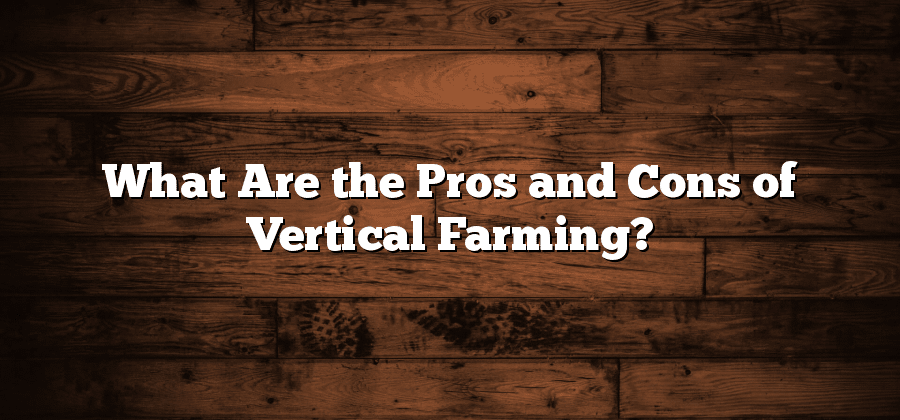– Efficient Use of Space
Vertical farming offers a promising solution to the world’s rapidly decreasing available land for agricultural use. By utilizing vertical space, crops can be grown in stacked layers, maximizing the use of limited land resources. This innovative approach to agriculture allows for the cultivation of a variety of crops, from leafy greens to fruits and vegetables, in a smaller footprint compared to traditional farming methods.
One of the key advantages of vertical farming is its ability to efficiently utilize space in urban areas where land is scarce. Vertical farming structures, such as high-rise buildings or greenhouses, allow for the stacking of multiple layers of crops, essentially multiplying the amount of produce that can be grown in a given area. This high-density approach enables farmers to achieve higher yields and maximize land productivity, ultimately meeting the increasing demand for fresh and nutritious food in urban environments.
– Year-Round Crop Production
Vertical farming offers several advantages when it comes to year-round crop production. One of the main benefits is the ability to control the environmental conditions within the vertical farm. These controlled environments allow for the adjustment of temperature, humidity, and lighting, creating optimal conditions for plant growth. As a result, crops can be grown consistently throughout the year, unaffected by external factors such as seasonal changes and adverse weather conditions. This not only ensures a steady and reliable supply of fresh produce but also helps to combat food scarcity and meet the increasing demands of a growing population.
Another advantage of year-round crop production in vertical farming is the efficient use of space. Traditional farming methods often require vast expanses of land to cultivate crops, which can be limited in urban areas. However, vertical farming allows for the utilization of vertical space, maximizing the use of available land. By stacking layers of crops vertically, multiple harvests can be obtained from a single floor area, significantly increasing the overall productivity of the farm. This efficient use of space not only maximizes crop yields but also reduces the need for expansive agricultural land, thus preserving natural resources and promoting sustainable farming practices.
– Reduction in Water Usage
Vertical farming presents a promising solution to the pressing issue of water scarcity in agriculture. By adopting innovative irrigation techniques and employing precision water management, vertical farms significantly reduce water usage compared to traditional farming methods. Through the use of hydroponics or aeroponics, where plants are grown in nutrient-rich water or mist instead of soil, water consumption can be drastically reduced. Additionally, the closed-loop systems characteristic of vertical farms allow for efficient water recycling, minimizing waste and maximizing water utilization.
Moreover, the controlled environment in vertical farms allows for optimal water usage by delivering the necessary amount directly to the plant roots, eliminating water loss through evaporation or runoff. By closely monitoring plant water requirements and adjusting irrigation accordingly, vertical farms ensure that water is used only when and where it is needed most. This precise water management not only conserves this precious resource but also improves crop yield and quality. With such efficient use of water, vertical farming holds great potential to mitigate the toll that traditional agriculture takes on water supplies, contributing to the long-term sustainability of our food production systems.
– Minimization of Pesticide Use
One of the key advantages of vertical farming is its ability to minimize pesticide use. With traditional farming methods, pesticides are often heavily relied upon to combat pests that can damage crops. However, in vertical farms, the controlled indoor environment creates a natural barrier against pests, reducing the need for pesticides.
By eliminating the use of pesticides, vertical farming not only promotes a healthier and safer environment but also produces crops that are free from chemical residues. This is particularly important for individuals who are conscious about their health and prefer organic produce. Moreover, the reduced pesticide use in vertical farming contributes to cleaner air and water, as the harmful chemicals present in pesticides can have detrimental effects on both humans and the environment.
Disadvantages of Vertical Farming:
One potential disadvantage of vertical farming is the high initial capital investment required to set up and maintain the vertical farming system. The costs associated with constructing the vertical infrastructure, purchasing the necessary equipment and technology, and hiring skilled operators can be quite substantial. Additionally, the ongoing operational costs, such as electricity and maintenance, can also add up over time.
Another challenge of vertical farming is the limited range of crops that can be effectively grown in this system. While leafy greens and herbs thrive in vertical farms, other types of crops, such as root vegetables and large fruits, may not be as feasible. This can limit the variety of produce that can be grown and may restrict the potential market opportunities for vertical farmers. However, ongoing advancements in technology and research might address these limitations in the future, opening up new possibilities for a wider range of crops to be cultivated vertically.






